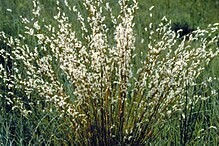Little Bluestem - first year plants
Little Bluestem is an iconic warm season grass of the prairie habitat that is commonly used in both landscaping and restoration projects. In shortgrass prairies, it is often the dominant species along with Side-oats Grama. In tallgrass prairies, companion grasses include Big Bluestem, Indian Grass, and Switch Grass.
One of the most widely distributed species of grass in the US, Little Bluestem is very drought-tolerant, but it can do well in moist situations too. Farmers have used this species for hay, but consecutive years of haying will likely cause the species to disappear. In a garden setting, Little Bluestem is valued for its blue-green color in the summer and, after the first frost, it turns beautiful shades of brown, copper, and crimson that will remain all winter. The grass gets fluffy white seed heads that also adds seasonal interest. Some gardeners choose to remove the seed fluff to control the spread of young seedlings.
Little Bluestem is an excellent plant for wildlife. The caterpillars of several skippers feed on the foliage, including Dusted Skipper, Cobweb Skipper, Ottoe Skipper, Indian Skipper, Swarthy Skipper, and the Crossline Skipper. Other insects that feed on Little Bluestem include grasshoppers, Prairie Walkingsticks, the leaf-mining beetles, thrips, spittlebugs, and leafhoppers. The seeds of this grass are eaten by songbirds.
